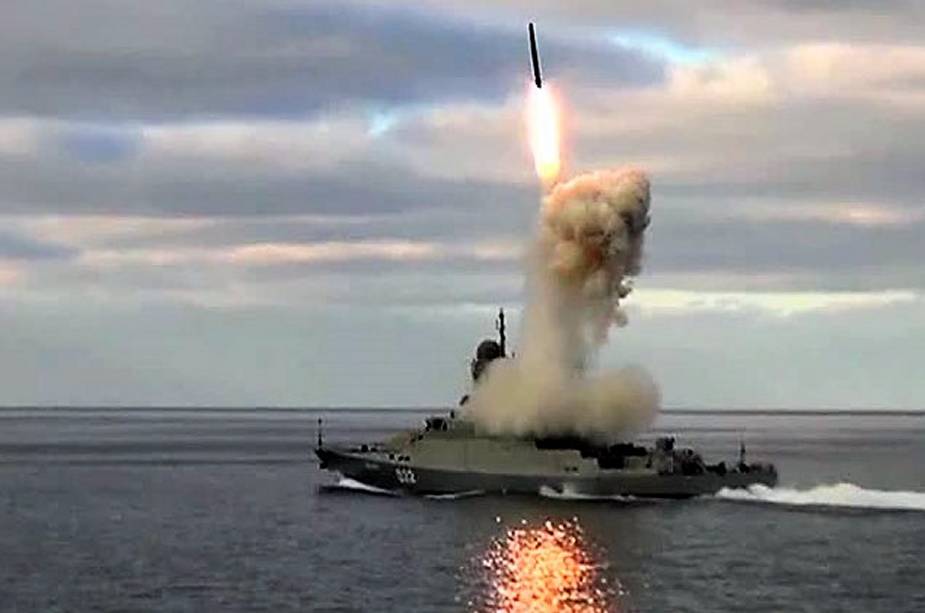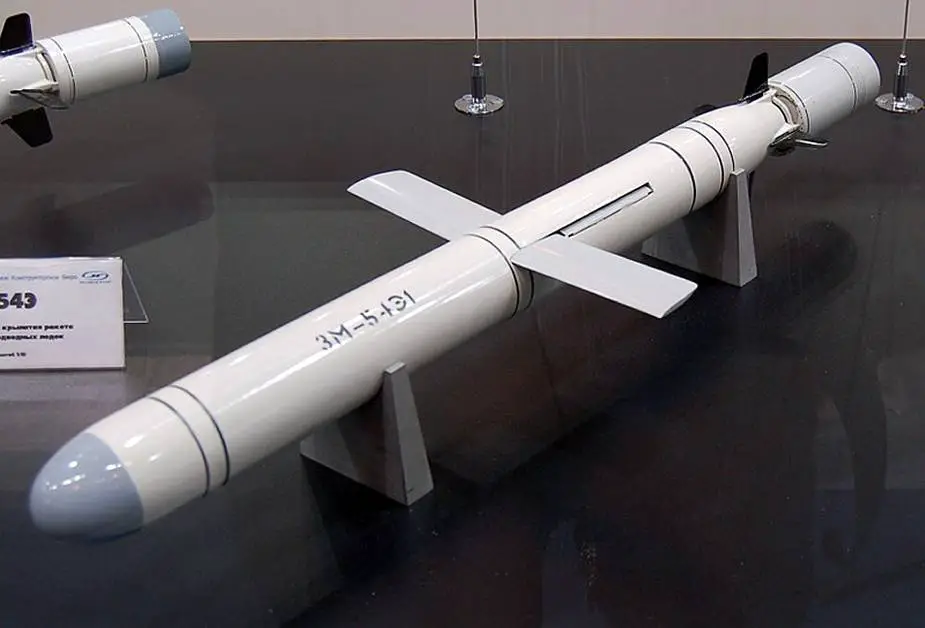- Army
- Conflicts in the world
- Israel - Iran conflict 2025
- Pakistan - India Conflict 2025
- Russia Ukraine War 2022
- Libya conflict day by day
- HAMAS - Israel War 2023
- Operation Serval in Mali French Army
- Sangaris operation Central African Republic
- Sangaris opération militaire République Centreafrique
- Ukraine - Russia conflict
- Syria conflict news
- Defence & Security Industry Technology
- Armies in the world
- Analysis Defense and Security Industry
- Conflicts in the world
- Navy
- Air
Russian Buyan-M-class ship fires salvo of 8 Kalibr cruise missiles at Ukrainian arms depot
MOSCOW, March 25. /TASS-DEFENSE/. The Russian Defense Ministry released a footage of a warship firing a salvo of eight Kalibr cruise missiles at a Ukrainian arms depot. It was the first demonstration of such a strike to the public.
Follow Army Recognition on Google News at this link

The Buyan-M Corvette "Uglich" launches a 3M-54 Kalibr anti-ship missile (Picture source: Russian MoD)
Defense Ministry Spokesman Igor Konashenkov said seaborne precision missiles hit an arsenal in the settlement of Orzhev 14 kilometers northwest of the city of Rovno. “The strike destroyed a major Ukrainian arsenal with arms and military hardware, also supplied by western countries,” he said.
The Kalibr missiles were reportedly fired by a Buyan-M-class small missile ship of project 21631 in the Black Sea. The footage shows the eight missiles blasting off one after another. The ship thus fired the whole round of missiles, as it carries eight of them.
Editor-in-Chief of the Independent Military Review Dmitry Litovkin said the salvo confirmed that the carriers of Kalibr missiles can simultaneously launch the whole round of munitions and remain in proper order.
“It is an important technical solution, which had to be tested. Can a warship launch 16 missiles? A submarine goes down 50 meters during such a salvo. There was such a possibility and it was tested,” he said.
Previously, the Defense Ministry released footage of one, two or three Kalibr launches. Litovkin recalled the Begemot-2 Soviet operation in the Barents Sea in 1990 when a nuclear submarine of the Northern fleet fired 16 ballistic missiles at a time at Kura range in several minutes. It was an unprecedented record of the domestic Navy. Ballistic missiles are much bigger than Kalibr.
Information exchange
Litovkin believes the Kalibr missiles exchanged information in flight. “Artificial intelligence is introduced into arms and hardware. It is possible that one missile sees the target and shares the information with other missiles. If one missile is downed, the rest will know where to fly. It is a netcentric situation in the battlefield,” he said.
“The salvo showed that Kalibr missiles have a real-time information exchange. The cruise missiles are actually robots,” the expert said.

3M-54 Kalibr anti-ship cruise missile (Picture source: Wikipedia)
Kalibr
Kalibr S-14 (NATO reporting name: SS-N-27 Sizzler) was developed by Novator Design Bureau in Yekaterinburg from Granat S-10 complex. It was for the first time demonstrated to the public in 1993.
Granat was designed as a response to US Tomahawk SLCM and GLCM. The design began in 1976. Granat 3M-10 was developed in 1983 into Alpha 3M-51 cruise missile that had an additional stage for fire from torpedo launchers. In 1993, a mockup of the missile was demonstrated at an arms show in Abu Dhabi and at MAKS-93.
After 1991, the designers focused on Club export option. It could be launched from submarines (Club-S) and warships (Club-N). The first 3M-54 was developed from Alpha and kept the main design. 3M-14 was developed from Granat. The range of the export option comprised 275-300 kilometers.
The Russian Navy uses 3M-54 and 3M-15 missiles for Kalibr-NK complex of surface warships with universal 3S14 launchers and Kalibr-PL for submarine torpedo launchers. The first complex was delivered with the Dagestan small missile ship of project 11661 in 2012. Various sources said its range varied from 1,400 to 2,600 km.
Kalibr was developed into ground, airborne, seaborne and underwater complexes, as well as an export option. Open sources said it is operated by Russia, India, and China.
Launcher
The universal 3S14 launcher promoted the use of Kalibr by the Russian Navy. The vertical launcher was designed by the Special Machine-Building Bureau of Almaz-Antey company.
It can fire Kalibr, Onyx and BrahMos missiles and is fit for prospective hypersonic Tsirkon, which is to complete acceptance trials in 2022.
The launchers are installed on the new-generation Russian warships with various displacements: frigates of projects 22350 and 11356, corvettes of projects 20385 and 20386, missile ships of project 11661, small missile ships of projects 21631 and 22800. Even patrol ships of project 22160 can carry the launcher. Upgraded cruisers of project 1144, destroyers of project 956 and big antisubmarine warfare ships of project 1155 will be also able to fire Kalibr.
The cruise missile can be also launched by Varshavyanka-class diesel-electric submarines of project 636.3 and Yasen-M-class SSGN of project 885M.
Engagement
The first combat engagement of the missiles took place in Syria. The Defense Ministry reported 13 engagements of at least 99 missiles.
The first launch was carried out by the Dagestan missile ship of project 11661, the Grad Sviyazhsk, the Uglich and the Veliky Ustyug small missile ships of project 21631 of the Caspian flotilla. They fired 26 Kalibr-NK at 11 terrorist objects in Syria from the Caspian Sea. They destroyed command posts, weapon depots, and camps of terrorists.
Defense Minister Sergey Shoigu said “the results of the strikes confirmed a high effectiveness of the missiles at major distances of nearly 1500 km.”
The first launch from a submarine took place on December 8, 2015. The Rostov-on-Don diesel-electric submarine of project 636.3 fired four Kalibr-PL from a submerged position at terrorist targets in Raqqa province. They destroyed two command posts. It was the first missile strike at a real adversary in the history of the Russian underwater fleet.
The Admiral Grigorovich frigate of project 11356R of the Black Sea fleet for the first time fired Kalibr missiles on November 15, 2016. She was followed by the Admiral Essen frigate, the Krasnodar, the Veliky Novgorod, and the Kolpino submarines of project 636.3. The latter two submarines delivered strikes from the Eastern Mediterranean and destroyed command posts, communication hubs, arms depots of terrorists southeast of Deir-ez-Zor. The Defense Ministry said seven missiles were fired from a submerged position to a distance of 500-670 km.
On October 5, 2017, the Veliky Novgorod and the Kolpino submarines of the Black Sea fleet fired ten Kalibr missiles and destroyed terrorist command posts, major arms depots and armor near al-Mayadin town.
Kalibr is an ideal non-nuclear strategic deterrence. It can carry both conventional and nuclear warhead. All Russian fleets are armed with Kalibr missiles, which offer a long and flexible outreach.


























